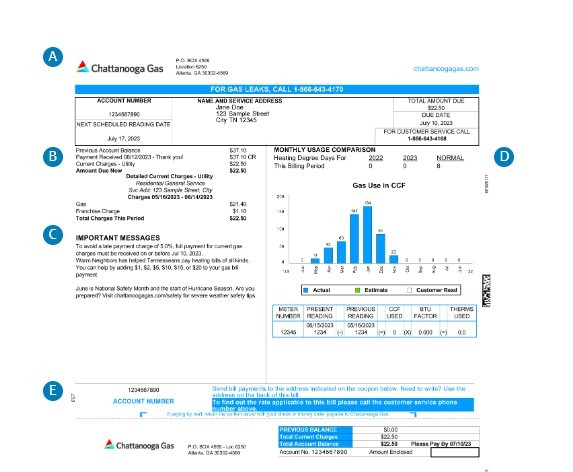Understanding Your Bill
Managing Your Winter Heating Bills
Every customer deserves natural gas they can depend on at a cost they can afford.
While natural gas remains the best value for your heating needs, costs typically increase in the winter because your heating system works harder and runs more often to keep you comfortable. To help manage your winter heating bills, consider weatherizing your home and following these additional energy-saving tips.
Your Monthly Natural Gas Bill: Understand Your Charges
Why Your Bill May Vary
Your gas bill will vary from month-to-month for a variety of reasons. Here are some common factors that cause your bill amount to change:
Factors you can't control:
- Changes in weather caused your heat to come on more often.
- The cost of gas changes from month to month.
- The number of days in your billing cycle changed slightly.
Factors you can control:
- Your lifestyle changed, such as working at home.
- You added new gas appliances, like a hot tub or a gas fireplace.
- Your appliance usage increased – most common during holidays, school vacations, when you entertain or have houseguests.
Ways you can help control your gas usage:
- Replace older, less energy-efficient gas appliances.
- Fix leaky hot water faucets.
- Replace furnace and air conditioning filters.
- Relocate thermostats away from drafty or chilly areas.
- Clean dryer lint traps.
- Repair windows that don't close properly. Replace single-pane windows.
- Close fireplace dampers when not in use.
To help lessen fluctuations in your bill year-round, consider enrolling in the Budget Plan program.

Your Monthly Natural Gas Bill: Understand Your Charges
Current natural gas costs across the United States reflect continued uncertainties and speculation over what the next 12 months hold globally for weather patterns, market conditions and escalating geopolitical events that continue to cause an uptick in the current and forward market for natural gas prices.
Learn MoreGlossary - Your Bill and Account
Account Nickname
A name given to an account to help to quickly identify – i.e., Mom’s Account, Rental Home Account, etc.
Account Number
A ten digit system-generated number used to identify a natural gas account.
Account Status
The state of a natural gas account for a specific service address.
Bank Account Number
The number used to identify a specific financial institution account.
Bill Image
An electronic snapshot of a paper bill.
Bill Payment Assistance
Programs developed to provide help in paying the energy bills of those customers in need. Additional dollars received in the amounts of $1, $2, $5, $10, $15 or $20 over a customer's amount due will post as a contribution to a specific program supported by our company.
All other amounts paid above the amount due appear as a credit to the account.
CCFs
A measure of the quantity of gas that is one hundred cubic feet of gas or 100,000 British Thermal Units (BTUs).
Customer Name
The name associated with a certain natural gas account.
Customer Type
Identifies an account as residential, commercial or industrial.
Deleted
The payment was deleted. Payments under this tab cannot be edited or deleted.
Days Used
The number of days within a meter reading cycle used to calculate the bill.
Due Date
The date your payment is due without incurring late charges, etc.
Favorite Account Number
The natural gas account chosen by a customer with multiple accounts as the default account.
Heating Degree Days
A weather measurement used to estimate the energy requirement for heating a home. Heating degree days are calculated as how much colder the average daily temperature is than 65 degrees F., the outdoor temperature that will trigger a typical homeowner to turn on the furnace to warm a home. Example: a day with an average temperature of 60 degrees equals a day with five HDD (65 F – 60 F).
Mailing Address
The address where the customer receives billing information and/or correspondence. The mailing address is oftentimes the service address.
Meter Number
A four to nine digit number used to identify a natural gas meter providing service to a premise. Some meter numbers are alphanumeric. Also used as a validation code for set-up of online account management.
Meter Reading
A measurement of the consumption taken from the meter at a specific service address.
Meter Status
The state of a natural gas meter assigned to a specific service address.
Next Reading Date
The next date the natural gas meter is scheduled to be read.
Password
Used to gain access to the system. Passwords must be six to twenty characters and contain one number. Passwords are case sensitive.
Payment Amount
The amount paid on an account.
Payment Date
The date a payment was posted to a natural gas account.
Pending
Payments made for a future day. Payments can be edited or deleted up to one day before the scheduled payment date.
Price for Natural Gas
The actual cost of the natural gas consumed, a direct pass through with no mark-up.
Processing
Payments made on current day. Payments cannot be edited or deleted.
Reading Details
An explanation of the method used to read a specific natural gas meter.
Routing Number
A nine digit bank code that appears on the bottom of a check and identifies the financial institution from which it is drawn.
Service Address
Sometimes referred to as premise address. It identifies the location of where natural gas service is provided.
Status
The status of an account could be the following:
Active – account is on and active at the premise
Final – service is inactive with an outstanding balance on the account
Therms
A unit of heating value equivalent to 100,000 British Thermal Units (BTUs).
Total Account Balance
The total amount of not yet billed charges. Example: Deposit Installments, Budget Bill Amounts and Deferred Payment Arrangements.
User ID
Used to identify a user. Your User Id must be unique and contain up to 20 characters.
Usage
The amount of natural gas used by a premises. Meter usage is usually measured by cubic feet or therms.



